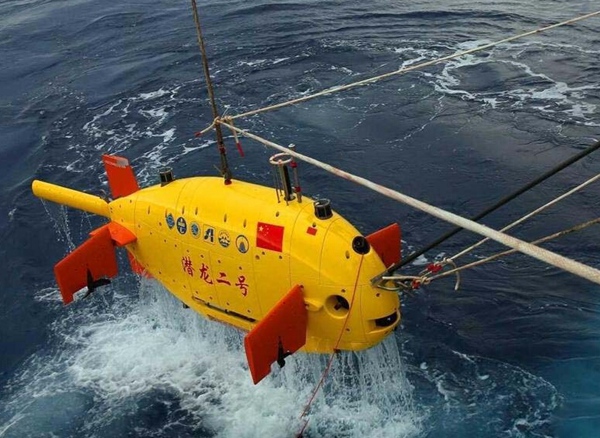


China’s self-developed unmanned autonomous underwater vehicle (AUV) Qianlong-2 (File photo)
SHENYANG, March 24 -- China's unmanned submersible Qianlong No.2 completed its first exploration in the southwest Indian Ocean early this month, scientists said at a press conference on Wednesday.
The autonomous underwater vehicle (AUV) with a length of 3.5 meters, height of 1.3 meters, and width of 0.7 meters, was independently designed by Chinese scientists and can dive to a depth of 4,500 meters.
It dived 16 times during the exploration from Dec. 16, 2015 to March 4, 2016 in the southwest Indian Ocean. Its work covered 218 square kilometers with the maximum depth of over 3.2 km, said Liu Jian, chief designer of Qianlong No.2. Liu is also a researcher with the Shenyang Institute of Automation under the Chinese Academy of Sciences.
The AUV explored sea areas rich in sulfide deposits that contain various metals, detected deep-sea terrain as well as photographed sulfide, basalt and marine organisms, according to Liu.
"Though it has a weight of 1.5 tonnes, Qianlong No.2 can move vigorously in deep-sea water," Liu said.
Its work was done on undulating sea floor terrain but no crash occurred during the whole exploration thanks to the forward looking sonar technology, said Xu Chunhui, another researcher at the institute.
The success of the trial exploration of Qianlong No.2 in the Indian Ocean has proved that the AUV can be put into practice in deep-sea mineral resource investigation since it can adapt to the complex terrain in the ocean and finish underwater tasks smoothly, said Liu.
Qianlong No.2 will play an important role in the future development and utilization of China's deep-sea resources, Liu said.
The Qianlong No.2 has been under development since 2011. It was unveiled in October 2014.
Before the practical detection missions in the Indian Ocean, it had undergone lake trials and sea trials.
 Thai most beautiful transgender Nong Poy release new photos
Thai most beautiful transgender Nong Poy release new photos Now and then photos of Shanghai Jiaotong University
Now and then photos of Shanghai Jiaotong University Is this what air travel will look like in 2050?
Is this what air travel will look like in 2050? Aerial view of watermelon terraces in S China's Baise
Aerial view of watermelon terraces in S China's Baise Traditional wedding of a post-80s Tibetan couple
Traditional wedding of a post-80s Tibetan couple Models in cheongsams present classical oriental beauty
Models in cheongsams present classical oriental beauty Second commissioned C28A corvette made by China enters Algerian Navy
Second commissioned C28A corvette made by China enters Algerian Navy Intoxicating Wuyuan in spring
Intoxicating Wuyuan in spring Gold and silver wares of Qing Dynasty exhibited in Shenyang Imperial Palace
Gold and silver wares of Qing Dynasty exhibited in Shenyang Imperial Palace Top 20 hottest women in the world in 2014
Top 20 hottest women in the world in 2014 Top 10 hardest languages to learn
Top 10 hardest languages to learn 10 Chinese female stars with most beautiful faces
10 Chinese female stars with most beautiful faces China’s Top 10 Unique Bridges, Highways and Roads
China’s Top 10 Unique Bridges, Highways and Roads Tax rumors spur buying of foreign products
Tax rumors spur buying of foreign products  Mekong cooperation has promising future
Mekong cooperation has promising future  Nuclear tests, border crimes change Chinese people’s attitude to N.Korea
Nuclear tests, border crimes change Chinese people’s attitude to N.Korea  Transplanted New Yorkers talk culture shock and urban affinities from the fast pace of Manhattan to the hutong of Beijing
Transplanted New Yorkers talk culture shock and urban affinities from the fast pace of Manhattan to the hutong of Beijing Day|Week